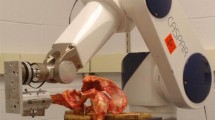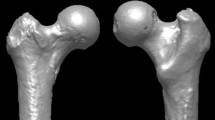Abstract
Purpose
To quantitatively evaluate the biomechanical sealing function of an intact labrum and the effect of labral–chondral separation, cerclage suture labral repair, vertical mattress suture repair and partial labrectomy on distraction load and hip joint centre (HJC) displacement.
Methods
Eight fresh-frozen cadaveric hips were tested using a navigation system for intra-operative kinematic analysis. A six-axis load cell was used to measure the manually applied force when performing the tests: hip pivoting movement and distraction. The HJC displacement that occurred during the distraction test has been evaluated in correspondence of seven different values of applied force. During the pivoting motion, the maximum value of HJC displacement was evaluated. Five different conditions were tested: labrum intact, labral–chondral separation, vertical mattress suture repair, cerclage suture repair, and partial labrectomy.
Results
With regard to HJC displacement using at fixed value of force, the paired sample t test underscored the statistically significant differences (p < 0.05) for each of the five tested conditions among themselves. Only the comparison of intact versus labral–chondral separation was not significantly different. During pivoting motion, a statistically significantly greater displacement was identified after labrectomy when compared with the cerclage suture repair (p = 0.03) and vertical mattress repair (p < 0.01) in medial–lateral direction. Along proximal—distal direction, a significant lower displacement after labrectomy was identified when compared to the cerclage suture repair (p = 0.03). Performing the pivoting motion at the extreme ranges of motion demonstrated a higher value of displacement after labrectomy when compared with all the previously tested conditions.
Conclusions
These results suggest that labral repair is important in the function of the hip and that the vertical mattress suture technique may be better than the cerclage suture repair.





Similar content being viewed by others
References
Ayeni OR, Alradwan H, de Sa D, Philippon MJ (2014) The hip labrum reconstruction: indications and outcomes—a systematic review. Knee Surg Sports Traumatol Arthrosc 22(4):737–743
Cadet ER, Chan AK, Vorys GC, Gardner T, Yin B (2012) Investigation of the preservation of the fluid seal effect in the repaired, partially resected, and reconstructed acetabular labrum in a cadaveric hip model. Am J Sports Med B 40(10):2218–2223
Duthon VB, Charbonnier C, Kolo FC, Magnenat-Thalmann N, Becker CD, Bouvet C, Coppens E, Hoffmeyer P, Menetrey J (2013) Correlation of clinical and magnetic resonance imaging findings in hips of elite female ballet dancers. Arthroscopy 29(3):411–419
Espinosa N, Beck M, Rothenfluh DA, Ganz R, Leunig M (2007) Treatment of femoro-acetabular impingement: preliminary results of labral refixation. Surgical technique. J Bone Joint Surg Am 89(Suppl 2 Pt.1):36–53
Espinosa N, Rothenfluh DA, Beck M, Ganz R, Leunig M (2006) Treatment of femoro-acetabular impingement: preliminary results of labral refixation. J Bone Joint Surg Am 88(5):925–935
Farjo LA, Glick JM, Sampson TG (1999) Hip arthroscopy for acetabular labral tears. Arthroscopy 15(2):132–137
Ferguson SJ, Bryant JT, Ganz R, Ito K (2003) An in vitro investigation of the acetabular labral seal in hip joint mechanics. J Biomech 36(2):171–178
Ferguson SJ, Bryant JT, Ganz R, Ito K (2000) The acetabular labrum seal: a poroelastic finite element model. Clin Biomech (Bristol, Avon) 15(6):463–468
Freehill MT, Safran MR (2011) The labrum of the hip: diagnosis and rationale for surgical correction. Clin Sports Med 30(2):293–315
Kelly BT, Shapiro GS, Digiovanni CW, Buly RL, Potter HG, Hannafin JA (2005) Vascularity of the hip labrum: a cadaveric investigation. Arthroscopy 21(1):3–11
Konrath GA, Hamel AJ, Olson SA, Bay B, Sharkey NA (1998) The role of the acetabular labrum and the transverse acetabular ligament in load transmission in the hip. J Bone Joint Surg Am 80(12):1781–1788
Larson CM, Giveans MR (2009) Arthroscopic debridement versus refixation of the acetabular labrum associated with femoroacetabular impingement. Arthroscopy 25(4):369–376
Larson CM, Giveans MR, Stone RM (2012) Arthroscopic debridement versus refixation of the acetabular labrum associated with femoroacetabular impingement: mean 3.5-year follow-up. Am J Sports Med 40(5):1015–1021
Lee S, Wuerz TH, Shewman E, McCormick FM, Salata MJ, Philippon MJ, Nho SJ (2015) Labral reconstruction with iliotibial band autografts and semitendinosus allografts improves hip joint contact area and contact pressure: an in vitro analysis. Am J Sports Med 43(1):98–104
McCarthy JC, Busconi B (1995) The role of hip arthroscopy in the diagnosis and treatment of hip disease. Can J Surg 38(suppl 1):S13–S17
Myers CA, Register BC, Lertwanich P, Ejnisman L, Pennington WW, Giphart JE, LaPrade RF, Philippon MJ (2011) Role of the acetabular labrum and the iliofemoral ligament in hip stability: an in vitro biplane fluoroscopy study. Am J Sports Med 39(Suppl):85S–91S
Narvani AA, Tsiridis E, Kendall S, Chaudhuri R, Thomas P (2003) A preliminary report on prevalence of acetabular labrum tears in sports patients with groin pain. Knee Surg Sports Traumatol Arthrosc 11(6):403–408
Nepple JJ, Philippon MJ, Campbell KJ, Dornan GJ, Jansson KS, LaPrade RF, Wijdicks CA (2014) The hip fluid seal, part II: the effect of an acetabular labral tear, repair, resection, and reconstruction on hip stability to distraction. Knee Surg Sports Traumatol Arthrosc 22(4):730–736
Philippon MJ, Briggs KK, Yen YM, Kuppersmith DA (2009) Outcomes following hip arthroscopy for femoroacetabular impingement with associated chondrolabral dysfunction: minimum two-year follow-up. J Bone Joint Surg Br 91(1):16–23
Philippon MJ, Nepple JJ, Campbell KJ, Dornan GJ, Jansson KS, LaPrade RF, Wijdicks CA (2014) The hip fluid seal, part I: the effect of an acetabular labral tear, repair, resection, and reconstruction on hip fluid pressurization. Knee Surg Sports Traumatol Arthrosc 22(4):722–729
Philippon MJ, Yen Y-M, Briggs KK, Kuppersmith DA, Maxwell RB (2008) Early outcomes after hip arthroscopy for femoroacetabular impingement in the athletic adolescent patient: a preliminary report. J Pediatr Orthop 28(7):705–710
Safran MR, Giordano G, Lindsey DP, Gold GE, Rosenberg J, Zaffagnini S, Giori NJ (2011) Strains across the acetabular labrum during hip motion: a cadaveric model. Am J Sports Med 39(Suppl):92S–102S
Safran MR, Lopomo N, Zaffagnini S, Signorelli C, Vaughn ZD, Lindsey DP, Gold G, Giordano G, Marcacci M (2013) In vitro analysis of peri-articular soft tissues passive constraining effect on hip kinematics and joint stability. Knee Surg Sports Traumatol Arthrosc 21(7):1655–1663
Sierra RJ, Trousdale RT (2009) Labral reconstruction using the ligamentum teres capitis: report of a new technique. Clin Orthop Relat Res 467(3):753–759
Song Y, Ito H, Kourtis L, Safran MR, Carter DR, Giori NJ (2012) Articular cartilage friction increases in hip joints after the removal of acetabular labrum. J Biomech 45(3):524–530
Takechi H, Nagashima H, Ito S (1982) Intra-articular pressure of the hip joint outside and inside the limbus. Nippon Seikeigeka Gakkai Zasshi 56(6):529–536
Terayama K, Takei T, Nakada K (1980) Joint space of the human knee and hip joint under a static load. Eng Med 9:66–74
Author information
Authors and Affiliations
Corresponding author
Rights and permissions
About this article
Cite this article
Signorelli, C., Bonanzinga, T., Lopomo, N. et al. Evaluation of the sealing function of the acetabular labrum: an in vitro biomechanical study. Knee Surg Sports Traumatol Arthrosc 25, 62–71 (2017). https://doi.org/10.1007/s00167-015-3851-x
Received:
Accepted:
Published:
Issue Date:
DOI: https://doi.org/10.1007/s00167-015-3851-x




